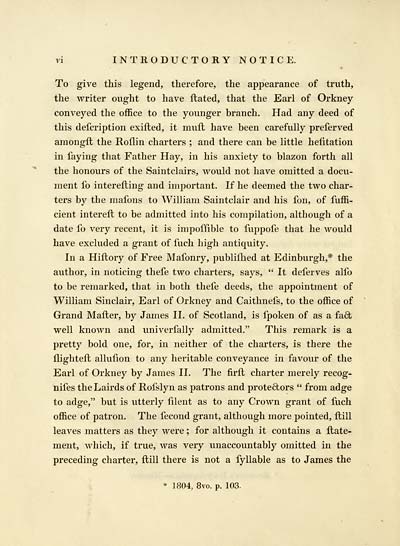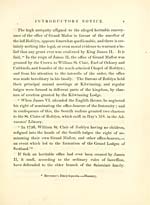Genealogie of the Sainteclaires of Rosslyn
(20) Page vi
Download files
Complete book:
Individual page:
Thumbnail gallery: Grid view | List view

vi INTRODUCTORY NOTICE.
To give this legend, therefore, the appearance of truth,
the writer ought to have ftated, that the Earl of Orkney
conveyed the office to the younger branch. Had any deed of
this defcription exifted, it mull have been carefully preferved
amongft the Roflin charters ; and there can be little heiitation
in faying that Father Hay, in his anxiety to blazon forth all
the honours of the Saintclairs, would not have omitted a docu-
ment fo interefting and important. If he deemed the two char-
ters by the mafons to William Saintclair and his fon, of fuffi-
cient intereft to be admitted into his compilation, although of a
date fo very recent, it is impoffible to fuppofe that he would
have excluded a grant of fuch high antiquity.
In a Hiftory of Free Mafonry, publifhed at Edinburgh,* the
author, in noticing thefe two charters, says, " It deferves alfo
to be remarked, that in both thefe deeds, the appointment of
William Sinclair, Earl of Orkney and Caithnefs, to the office of
Grand Mafter, by James II. of Scotland, is fpoken of as a fact
well known and univerfally admitted." This remark is a
pretty bold one, for, in neither of the charters, is there the
flighteft allufion to any heritable conveyance in favour of the
Earl of Orkney by James II. The firft charter merely recog-
nifes the Lairds of Rofslyn as patrons and protectors " from adge
to adge," but is utterly filent as to any Crown grant of fuch
office of patron. The fecond grant, although more pointed, ftill
leaves matters as they were ; for although it contains a ftate-
ment, which, if true, was very unaccountably omitted in the
preceding charter, ftill there is not a fyllable as to James the
* 1804, 8vo. p. 103.
To give this legend, therefore, the appearance of truth,
the writer ought to have ftated, that the Earl of Orkney
conveyed the office to the younger branch. Had any deed of
this defcription exifted, it mull have been carefully preferved
amongft the Roflin charters ; and there can be little heiitation
in faying that Father Hay, in his anxiety to blazon forth all
the honours of the Saintclairs, would not have omitted a docu-
ment fo interefting and important. If he deemed the two char-
ters by the mafons to William Saintclair and his fon, of fuffi-
cient intereft to be admitted into his compilation, although of a
date fo very recent, it is impoffible to fuppofe that he would
have excluded a grant of fuch high antiquity.
In a Hiftory of Free Mafonry, publifhed at Edinburgh,* the
author, in noticing thefe two charters, says, " It deferves alfo
to be remarked, that in both thefe deeds, the appointment of
William Sinclair, Earl of Orkney and Caithnefs, to the office of
Grand Mafter, by James II. of Scotland, is fpoken of as a fact
well known and univerfally admitted." This remark is a
pretty bold one, for, in neither of the charters, is there the
flighteft allufion to any heritable conveyance in favour of the
Earl of Orkney by James II. The firft charter merely recog-
nifes the Lairds of Rofslyn as patrons and protectors " from adge
to adge," but is utterly filent as to any Crown grant of fuch
office of patron. The fecond grant, although more pointed, ftill
leaves matters as they were ; for although it contains a ftate-
ment, which, if true, was very unaccountably omitted in the
preceding charter, ftill there is not a fyllable as to James the
* 1804, 8vo. p. 103.
Set display mode to:
![]() Universal Viewer |
Universal Viewer | ![]() Mirador |
Large image | Transcription
Mirador |
Large image | Transcription
Images and transcriptions on this page, including medium image downloads, may be used under the Creative Commons Attribution 4.0 International Licence unless otherwise stated. ![]()
| Histories of Scottish families > Genealogie of the Sainteclaires of Rosslyn > (20) Page vi |
|---|
| Permanent URL | https://digital.nls.uk/94822766 |
|---|
| Description | A selection of almost 400 printed items relating to the history of Scottish families, mostly dating from the 19th and early 20th centuries. Includes memoirs, genealogies and clan histories, with a few produced by emigrant families. The earliest family history goes back to AD 916. |
|---|

